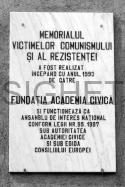 A fost gândit şi iniţiat încă din 1992 de către preşedinta de la acea dată a Alianţei Civice, Ana Blandiana, şi realizat în următorul deceniu împreună cu Romulus Rusan şi o prestigioasă echipă de istorici, arhitecţi, constructori şi designeri.
A fost gândit şi iniţiat încă din 1992 de către preşedinta de la acea dată a Alianţei Civice, Ana Blandiana, şi realizat în următorul deceniu împreună cu Romulus Rusan şi o prestigioasă echipă de istorici, arhitecţi, constructori şi designeri.
În ianuarie 1993, Ana Blandiana a predat proiectul Memorialului la Consiliul Europei. După ce două delegaţii de experţi au vizitat Sighetul, Consiliul Europei a întocmit, în 1995, un studiu-raport şi a luat Memorialul sub egida sa. În 1998 Consiliul Europei aşază Memorialul de la Sighet printre principalele locuri de păstrare a memoriei continentului, alături de Memorialul de la Auschwitz şi Memorialul Păcii din Normandia.
Situat departe de Bucureşti, în extremitatea nordică a României, dar în centrul Europei de Est, Memorialul are ca scop reconstituirea şi păstrarea memoriei unor popoare, în particular a celui român, cărora timp de jumătate de secol li s-a indus în conştiinţă o istorie falsă.
Sighet is an “opening” through which the history of one half of Europe is released and makes room for the freedom of truth.
Jardar Seim (1995)
Thanks to the numerous translations in the “Black Book of Communism”, I travel widely in Eastern Europe. I have not yet discovered in any other ex-communist country initiatives with the same breadth as Sighet. There are, of course, related initiatives, but which are, for the time being, far from achieving the quality of what has been done at Sighet. With its historical and scientific dimension, (…) the Sighet Memorial should be taken as a model.
Stéphane Courtois (1999)
I appreciate the unique and highly useful Sighet Memorial Project, and Mrs Ana Blandiana, the soul of this project, whom I have had the pleasure to meet on the occasion of a visit to Bucharest.
Václav Havel (2001)
At Sighet – where the Summer School is held, we meet Stéphane Courtois, Doina Cornea and many other friends and well-known figures. The Memorial has grown since the last time I was here, at the same time as its international reputation (…) The Memorial is a well organised centre of historical research.
Sanda Stolojan (2001)
What is unique at Sighet is the Summer School. Of course, the same thing has been attempted in other places… But, from this point of view, the Memorial is unique.
Vladimir Bukovski (2002)
I have said it in my turn many times and I repeat: their achievement – the Memorial with everything it includes – is one that is extraordinary in the context of our institutional villainy, of official sabotage (whether deliberate or instinctive), of the refusal – quasi-universal at the domestic and international level – to compare, equate, conjoin the horrors of communism with those of fascism and Nazism.
Dan C. Mihăilescu (2006)
I am here in principle to learn, and I have learned much. I shall have to do some serious research after this experience, which I shall take back to Washington with me. I leave here with extraordinary ideas, such as that expressed by Ana Blandiana, regarding memory as a form of justice, or that of Mr Romulus Rusan, about as yet sensitive recent history as raw flesh.
Christian F. Östermann (2006)
The Sighet Memorial is a world memorial, a monument dedicated to the struggle against communism. This Memorial is a world monument almost unique dedicated to the struggle of the individual against power, the struggle of memory against forgetting, the struggle of victims against the oppressors. There is almost nothing like it.
Tom Blanton (2007)

